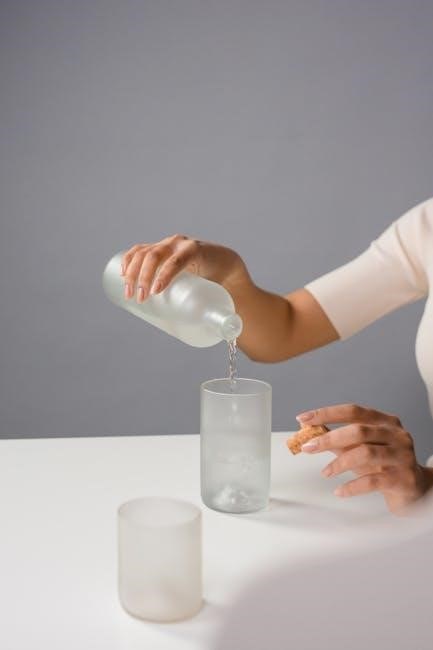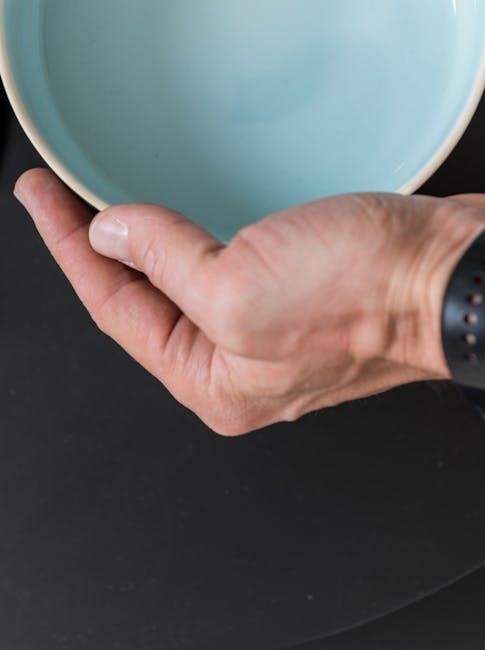A water softener is a device designed to remove calcium and magnesium from water, reducing hardness. It uses resin beads to capture minerals and regenerate periodically for optimal performance. This system improves water quality, reducing scaling and enhancing appliance efficiency. Understanding its operation and benefits is essential for maintaining effective water treatment in your home.
1.1 What is a Water Softener?
A water softener is a device designed to remove calcium and magnesium ions from water, which cause hardness. It uses a process called ion exchange, where these minerals are replaced with sodium or potassium ions. The system typically includes a resin tank, control valve, and brine tank. The resin beads capture calcium and magnesium, and during regeneration, a saltwater solution rinses them clean. This process ensures softened water for household use, reducing scaling in pipes and appliances. Water softeners are customizable to suit various water conditions and household needs, making them an essential solution for homes with hard water issues.
1.2 Benefits of Using a Water Softener
Using a water softener provides numerous benefits, including reduced scaling in pipes and appliances, cleaner clothes, and dishes. It prevents mineral buildup, ensuring better water flow and efficiency in water heaters. Soft water also reduces soap scum, making cleaning easier and improving skin and hair health. Additionally, it protects appliances like dishwashers and laundry machines from damage caused by hard water. Many users report lower energy bills due to increased appliance efficiency. Overall, a water softener enhances water quality, making daily tasks more convenient while protecting your home’s plumbing system. It is a practical solution for homes with hard water, offering long-term savings and improved comfort.

Installation Guidelines
Place the softener near a drain, ensuring easy access to water supply and power. Connect inlet/outlet pipes, install bypass valves, and secure electrical connections properly for safe operation.
2.1 Choosing the Right Location
Selecting a suitable location for your water softener is crucial for optimal performance and maintenance. Ensure it is placed near a drain to facilitate regeneration and brine discharge. The area should be dry, level, and protected from extreme temperatures. Keep the softener at least 10 feet away from water-using appliances to prevent interference. Proximity to a grounded electrical outlet is necessary, and the location should allow easy access for servicing. Avoid placing it in confined spaces or areas prone to flooding to ensure safety and longevity of the system. Proper placement will also minimize installation complexity and operational noise.
2.2 Connecting to Water Supply
To connect your water softener to the water supply, first shut off the main water valve to prevent water flow during installation. Locate the main water line and cut it to install the bypass valve, ensuring it’s positioned correctly. Attach the inlet and outlet lines to the softener, securing them tightly to avoid leaks. Connect the drain line to a nearby drain or standpipe, ensuring proper elevation for waste water disposal. Finally, attach the brine tank line to the softener and place the overflow tube in the brine tank. Turn the water supply back on gradually to check for leaks, ensuring all connections are secure and functioning properly. This setup ensures safe and efficient water treatment.
2.3 Electrical Setup and Requirements
Your water softener requires a 24V DC power supply, typically provided by a direct plug-in transformer included with the unit. Ensure the transformer is connected to a grounded 120V, 60 Hz household outlet in a dry location, protected by a circuit breaker or fuse. Avoid using extension cords, as they may cause power issues. The system should be plugged into a nearby outlet to maintain accessibility and safety. Always follow the manufacturer’s wiring instructions to prevent electrical hazards. Proper grounding and adherence to local electrical codes are essential for safe operation. Ensure the power supply is easily accessible for maintenance or troubleshooting purposes.
2.4 Drain and Venting Requirements

Ensure the water softener is installed near a drain line to facilitate proper wastewater disposal. A 1/2-inch drain line is typically recommended, and it should slope downward to prevent backflow. Avoid sharp bends or kinks in the drain line to maintain smooth water flow. Install a by-pass valve to allow water flow continuation during maintenance or regeneration. The brine tank should be placed no more than 15 feet from the resin tank to prevent overflow issues. Proper venting is essential to avoid siphoning and ensure efficient regeneration cycles. Always follow local plumbing codes and manufacturer guidelines for drain and venting configurations to guarantee safe and effective operation of your water softener system.

Operating Your Water Softener
Understand the control panel to monitor and adjust settings. Set regeneration cycles based on water usage. Regularly check salt levels and water hardness to ensure optimal performance.
3.1 Understanding the Control Panel
The control panel is the central interface for monitoring and adjusting your water softener’s settings. It typically features a display screen, buttons, and indicator lights. The display shows water hardness levels, regeneration status, and error codes. Buttons allow you to navigate menus, set regeneration cycles, and adjust settings like salt dosage or water usage. Indicator lights notify you of system status, low salt levels, or potential issues. Familiarize yourself with the panel to optimize performance. Regularly check the display for alerts and use the buttons to customize settings based on your water needs. Refer to the manual for specific button functions and troubleshooting guides.
3.2 Setting Up Regeneration Cycles
Regeneration cycles are essential for maintaining your water softener’s efficiency. These cycles clean the resin beads by flushing out captured minerals and replenishing them with salt or potassium. To set up regeneration, access the control panel and navigate to the regeneration menu. Choose between manual or automatic cycles, depending on your water usage and hardness levels. Automatic regeneration is recommended for convenience, as it adjusts based on actual water demand. Set the regeneration frequency, typically every 3-14 days, and select a start time, usually during low water usage. Ensure the salt levels are adequate before initiating a cycle. Monitor and adjust settings as needed to optimize performance and prevent wasted resources.
3.3 Monitoring Salt Levels
Monitoring salt levels in your water softener is crucial for optimal performance. Low salt levels can lead to incomplete regeneration and reduced water softening efficiency. Check the salt level in the brine tank regularly, typically once a month. Ensure the salt level does not fall below the recommended minimum, as this can cause the resin beads to become clogged with minerals. Always use high-quality salt or potassium recommended by the manufacturer. Avoid overfilling, as this can cause bridging or caking. If you notice a sudden drop in salt levels, it may indicate increased water usage or higher hardness levels. Adjust your regeneration settings or salt dosage as needed to maintain consistent water quality and system functionality.
Maintenance and Troubleshooting
Regularly inspect and clean the resin tank and brine injector to ensure proper function. Check for salt bridges and replenish salt as needed. Monitor water hardness levels and adjust settings if necessary. If issues arise, refer to the troubleshooting guide in your manual for solutions to common problems like low water pressure or excessive salt usage. Scheduling annual professional maintenance can prevent major repairs and extend the system’s lifespan. Always follow safety precautions when handling electrical components or chemicals. Keep the system’s surroundings clean and dry to avoid corrosion or mold growth. Addressing minor issues promptly can prevent them from becoming major concerns.
4.1 Regular Maintenance Tasks
Regular maintenance ensures optimal performance. Inspect the resin tank and brine injector for cleanliness. Check salt levels monthly, refilling as needed. Prevent salt bridges by breaking up solidified salt. Ensure the brine tank doesn’t overflow. Monitor water hardness and adjust settings if necessary. Schedule annual professional maintenance for a thorough check. Keep the surrounding area clean and dry to prevent corrosion and mold growth. Addressing these tasks prevents major issues and extends system lifespan.
4.2 Common Issues and Solutions
Common issues with water softeners include low salt levels, causing hardness to return. Check and refill salt regularly. If water remains hard, manually regenerate the system. Blockages in the brine injector or venturi tube can disrupt regeneration; clean these parts as needed. If the softener doesn’t regenerate, ensure the control panel is programmed correctly and power is supplied. High water usage or continuous regeneration may indicate a faulty timer or stuck valve, requiring professional repair. Addressing these issues promptly ensures consistent soft water and system longevity. Always refer to the manual for specific troubleshooting steps for your model.

Safety Precautions
Handling salt and chemicals safely, ensuring electrical connections are secure, and following installation guidelines are crucial for safe operation. Always keep the area dry to prevent hazards.
5.1 Handling Salt and Chemicals
Always wear protective gloves and eyewear when handling salt or chemicals for your water softener. Avoid inhaling dust when pouring salt. Keep the salt container clean and dry to prevent clumping. Ensure the brine tank is properly sealed to prevent leaks. Store all chemicals in a cool, dry place out of reach of children. Follow the manufacturer’s instructions for adding salt and cleaning the tank. Regularly check the salt level to maintain efficiency. Never mix different types of salt without consulting the manual. Dispose of empty salt bags responsibly to avoid environmental contamination. Proper handling ensures safe and effective system operation.
5.2 Electrical Safety
Ensure the water softener is plugged into a grounded 120V, 60Hz household outlet in a dry location. Never use extension cords or modify the power supply. Keep the electrical components away from water to prevent shocks. Install a Ground Fault Circuit Interrupter (GFCI) if required by local codes. Avoid touching electrical parts with wet hands. Regularly inspect cords and connections for damage. If damage is found, unplug and contact a professional. Always unplug the unit before servicing. Ensure proper ventilation around the softener to prevent overheating. Follow all safety guidelines in the manual to maintain safe operation and protect against electrical hazards.

Warranty Information
Register your water softener to activate the warranty. Coverage varies by model, typically 1-5 years. Excludes damage from misuse or natural disasters. See manual for details.

6.1 Understanding Your Warranty
Your water softener warranty covers parts and labor for defects in materials and workmanship. Registration is required to activate the warranty, which varies by model and brand. Most warranties last 1-5 years, with some extending up to 10 years for specific components. Exclusions include damage from misuse, neglect, or natural disasters. Review your manual for detailed terms and conditions. Contact the manufacturer or local dealer for warranty claims or questions. Proper installation and maintenance are essential to ensure warranty validity. Keep your proof of purchase and registration confirmation for reference.
Additional Resources
Visit manufacturer websites like Culligan, Morton, and Whirlpool for downloadable manuals, troubleshooting guides, and installation instructions. Online forums and support pages offer additional assistance and FAQs.

7.1 Where to Find Manuals Online
Manufacturer websites like Culligan, Morton, and Whirlpool provide downloadable PDF manuals for water softeners. Visit their support sections or product pages to access guides specific to your model. Discount Water Softeners and other retailers also offer manuals for various systems. Additionally, platforms like ManualsLib or ManualsOnline host a wide range of user manuals. Ensure to verify the source for authenticity and compatibility with your device. Always use Adobe Acrobat Reader to view these documents, as most manuals are in PDF format.

